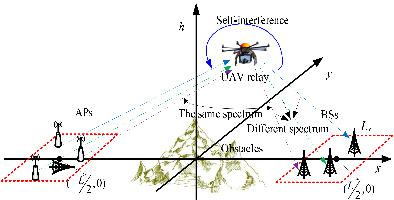当前位置:
X-MOL 学术
›
Trans. Emerg. Telecommun. Technol.
›
论文详情
Our official English website, www.x-mol.net, welcomes your feedback! (Note: you will need to create a separate account there.)
Joint altitude, power control, and bandwidth allocation optimization for unmanned aerial vehicle‐enabled reliable communications
Transactions on Emerging Telecommunications Technologies ( IF 3.6 ) Pub Date : 2020-05-27 , DOI: 10.1002/ett.3983 Lei Wang 1 , Bo Hu 1 , Feng Wang 2 , Shanzhi Chen 2 , Jian Cui 1
Transactions on Emerging Telecommunications Technologies ( IF 3.6 ) Pub Date : 2020-05-27 , DOI: 10.1002/ett.3983 Lei Wang 1 , Bo Hu 1 , Feng Wang 2 , Shanzhi Chen 2 , Jian Cui 1
Affiliation

|
Unmanned aerial vehicles (UAVs) as aerial relays have found many applications in the current communication network. Since the air‐to‐ground (AtG) link differs from the terrestrial link, ensuring a reliable AtG transmission remains to be a meaningful issue. This article investigates that a UAV works as an aerial relay to forward information from multiple access points to multiple remote base stations in an emergency situation. Using the full‐duplex decode‐and‐forward relaying mode, we formulate a problem to minimize the maximum outage probability among all links, jointly optimizing the UAV altitude, power control, and bandwidth allocation. The outage probability function takes into account the line‐of‐sight probability‐based AtG fading and the self‐interference introduced by full‐duplex relaying, both of which make our formulated problem nonconvex. We reformulate the outage probability function into a more tractable function. Then, we decouple the original problem into two subproblems, that is, altitude optimization as well as power control and bandwidth allocation. Each subproblem is solved by the successive convex optimization technique, and an overall iteration algorithm is proposed to solve the original problem based on the block coordinate descent theory. Simulation results reveal the reliability gain of our proposed algorithm compared with our designed benchmark. Besides, the optimal UAV three‐dimensional location that minimizes the global min‐max outage probability is found by numerical simulations. Finally, the average throughput gain can also be obtained by our proposed algorithm.
中文翻译:

联合高度,功率控制和带宽分配优化,实现了无人机可靠通信
作为空中中继器的无人机已经在当前的通信网络中得到了许多应用。由于空对地(AtG)链路与地面链路不同,因此确保可靠的AtG传输仍然是一个有意义的问题。本文研究了在紧急情况下,UAV可以作为空中中继器将信息从多个接入点转发到多个远程基站。通过使用全双工解码和转发中继模式,我们提出了一个问题,以最小化所有链路之间的最大中断概率,从而共同优化无人机高度,功率控制和带宽分配。中断概率函数考虑了基于视线概率的AtG衰落和全双工中继引入的自干扰,这两者都使我们提出的问题不凸。我们将中断概率函数重新构造为更易于处理的函数。然后,我们将原始问题分解为两个子问题,即高度优化以及功率控制和带宽分配。通过逐次凸优化技术解决了每个子问题,并提出了一种基于块坐标下降理论的整体迭代算法来求解原始问题。仿真结果表明,与我们设计的基准相比,我们提出的算法具有更高的可靠性。此外,通过数值模拟可以找到使全局最小-最大中断概率最小的最佳无人机三维位置。最后,平均吞吐率增益也可以通过我们提出的算法获得。我们将原始问题分解为两个子问题,即高度优化以及功率控制和带宽分配。通过逐次凸优化技术解决了每个子问题,并提出了一种基于块坐标下降理论的整体迭代算法来求解原始问题。仿真结果表明,与我们设计的基准相比,我们提出的算法具有更高的可靠性。此外,通过数值模拟可以找到使全局最小-最大中断概率最小的最佳无人机三维位置。最后,平均吞吐率增益也可以通过我们提出的算法获得。我们将原始问题分解为两个子问题,即高度优化以及功率控制和带宽分配。通过逐次凸优化技术解决了每个子问题,并提出了一种基于块坐标下降理论的整体迭代算法来求解原始问题。仿真结果表明,与我们设计的基准相比,我们提出的算法具有更高的可靠性。此外,通过数值模拟可以找到使全局最小-最大中断概率最小的最佳无人机三维位置。最后,平均吞吐率增益也可以通过我们提出的算法获得。通过逐次凸优化技术解决了每个子问题,并提出了一种基于块坐标下降理论的整体迭代算法来求解原始问题。仿真结果表明,与我们设计的基准相比,我们提出的算法具有更高的可靠性。此外,通过数值模拟可以找到使全局最小-最大中断概率最小的最佳无人机三维位置。最后,平均吞吐率增益也可以通过我们提出的算法获得。通过逐次凸优化技术解决了每个子问题,并提出了一种基于块坐标下降理论的整体迭代算法来求解原始问题。仿真结果表明,与我们设计的基准相比,我们提出的算法具有更高的可靠性。此外,通过数值模拟可以找到使全局最小-最大中断概率最小的最佳无人机三维位置。最后,平均吞吐率增益也可以通过我们提出的算法获得。通过数值模拟可以找到使全局最小-最大中断概率最小的最佳UAV三维位置。最后,平均吞吐率增益也可以通过我们提出的算法获得。通过数值模拟可以找到使全局最小-最大中断概率最小的最佳UAV三维位置。最后,平均吞吐率增益也可以通过我们提出的算法获得。
更新日期:2020-05-27
中文翻译:

联合高度,功率控制和带宽分配优化,实现了无人机可靠通信
作为空中中继器的无人机已经在当前的通信网络中得到了许多应用。由于空对地(AtG)链路与地面链路不同,因此确保可靠的AtG传输仍然是一个有意义的问题。本文研究了在紧急情况下,UAV可以作为空中中继器将信息从多个接入点转发到多个远程基站。通过使用全双工解码和转发中继模式,我们提出了一个问题,以最小化所有链路之间的最大中断概率,从而共同优化无人机高度,功率控制和带宽分配。中断概率函数考虑了基于视线概率的AtG衰落和全双工中继引入的自干扰,这两者都使我们提出的问题不凸。我们将中断概率函数重新构造为更易于处理的函数。然后,我们将原始问题分解为两个子问题,即高度优化以及功率控制和带宽分配。通过逐次凸优化技术解决了每个子问题,并提出了一种基于块坐标下降理论的整体迭代算法来求解原始问题。仿真结果表明,与我们设计的基准相比,我们提出的算法具有更高的可靠性。此外,通过数值模拟可以找到使全局最小-最大中断概率最小的最佳无人机三维位置。最后,平均吞吐率增益也可以通过我们提出的算法获得。我们将原始问题分解为两个子问题,即高度优化以及功率控制和带宽分配。通过逐次凸优化技术解决了每个子问题,并提出了一种基于块坐标下降理论的整体迭代算法来求解原始问题。仿真结果表明,与我们设计的基准相比,我们提出的算法具有更高的可靠性。此外,通过数值模拟可以找到使全局最小-最大中断概率最小的最佳无人机三维位置。最后,平均吞吐率增益也可以通过我们提出的算法获得。我们将原始问题分解为两个子问题,即高度优化以及功率控制和带宽分配。通过逐次凸优化技术解决了每个子问题,并提出了一种基于块坐标下降理论的整体迭代算法来求解原始问题。仿真结果表明,与我们设计的基准相比,我们提出的算法具有更高的可靠性。此外,通过数值模拟可以找到使全局最小-最大中断概率最小的最佳无人机三维位置。最后,平均吞吐率增益也可以通过我们提出的算法获得。通过逐次凸优化技术解决了每个子问题,并提出了一种基于块坐标下降理论的整体迭代算法来求解原始问题。仿真结果表明,与我们设计的基准相比,我们提出的算法具有更高的可靠性。此外,通过数值模拟可以找到使全局最小-最大中断概率最小的最佳无人机三维位置。最后,平均吞吐率增益也可以通过我们提出的算法获得。通过逐次凸优化技术解决了每个子问题,并提出了一种基于块坐标下降理论的整体迭代算法来求解原始问题。仿真结果表明,与我们设计的基准相比,我们提出的算法具有更高的可靠性。此外,通过数值模拟可以找到使全局最小-最大中断概率最小的最佳无人机三维位置。最后,平均吞吐率增益也可以通过我们提出的算法获得。通过数值模拟可以找到使全局最小-最大中断概率最小的最佳UAV三维位置。最后,平均吞吐率增益也可以通过我们提出的算法获得。通过数值模拟可以找到使全局最小-最大中断概率最小的最佳UAV三维位置。最后,平均吞吐率增益也可以通过我们提出的算法获得。



























 京公网安备 11010802027423号
京公网安备 11010802027423号